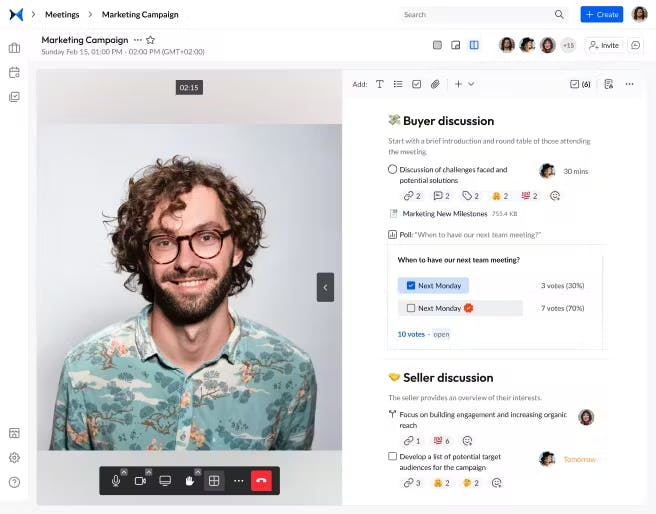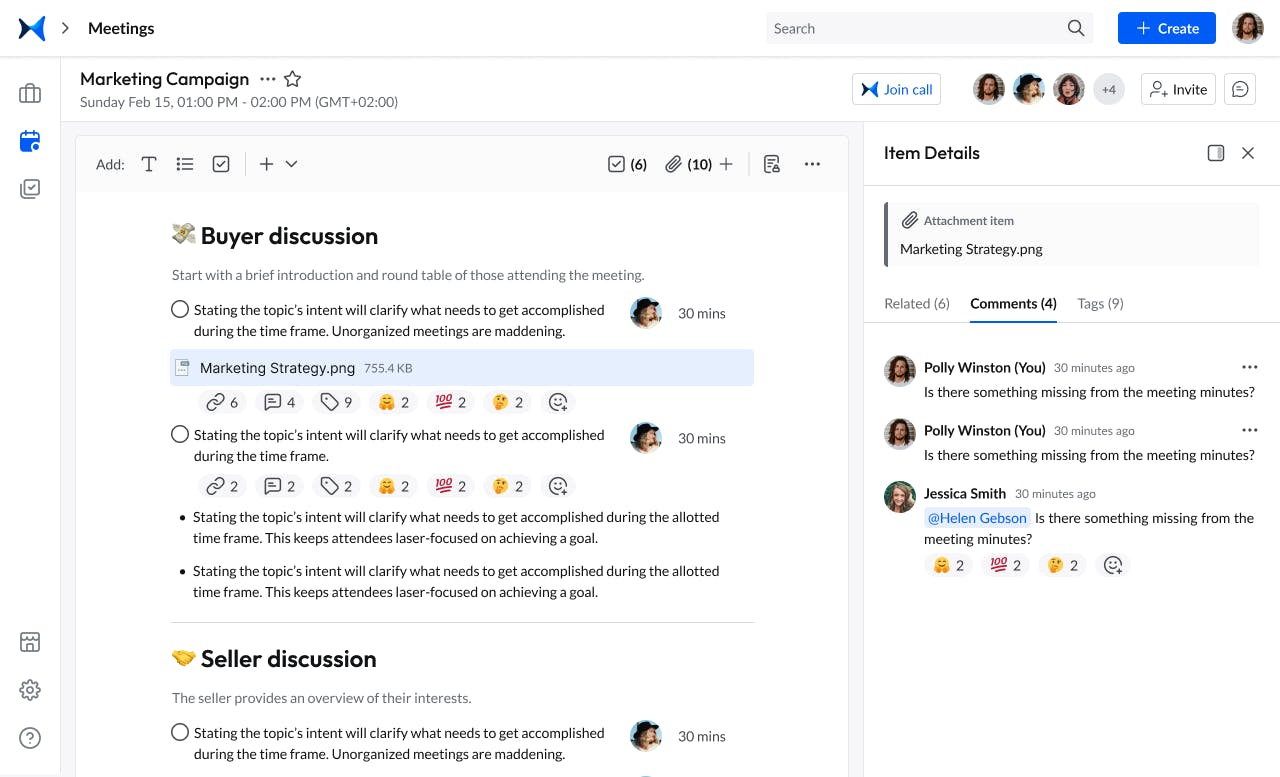December 21, 2021 · 10 min read
How to Take Meeting Minutes as a Pro + Editable Minutes Templates

Huda Gamal

Millions of meetings are called for and run everyday in the US and around the globe; yet, how many are actually productive? To how extent are the outcomes acted upon? How many of those meetings follow a pre-shared agenda and conclude with professionally written meeting minutes?
Just to set expectations, this article discusses meeting minutes in details, so it's a bit lengthy — we wanted it to be a complete guide on how to take meeting minutes as a pro. Feel free to click and jump to a certain section:
Meeting minutes definition
Meeting minutes are the official, written record for the discussions, actions, and decisions made and taken during a meeting.
Taking meeting minutes is a fundamental part of any meeting, whether formal, like board meetings, or informal, like brainstorming or team meetings.
Meeting minutes act as the official agreement of what took place during the meeting. These meeting notes are then shared with all meeting attendees and with those who were invited but couldn't attend, as well as parties that need to be aware of the meeting outcomes. Meeting minutes are also the official documentation of actions and decisions in case they need to be revisited later on.
Purpose of meeting minutes
Meeting minutes did not acquire such importance from nowhere; they serve as a record of actions, a reminder of assignments, an evidence of deadlines, and a benefit for everyone in the group.
Historical record
Meeting minutes are the archived records for an organization's plans and goals.
Future reference
Participants and those who have access to such data can revisit meeting minutes for future reference. They may also use them to measure progression along a period of time or a number of meetings.
Legal protection
For organizations and big companies, meeting minutes act as the official documentation to confirm the ethical and fair practices of the organization during its meetings.
Documented proof
Meeting minutes can be referred to at any time as a proof of why and how a company came to certain decisions, who agreed, and who objected.
📈 A recent study revealed that "80% of US employees feel stressed due to ineffective company communication." Taking, sharing, and keeping meeting minutes can definitely solve communication issues and clear a lot of misunderstandings.
How to take formal meeting minutes?
Attendees of a formal meeting, like board meetings, assign a minutes taker to write down meeting notes. These notes always tend to be formal in language and structure.
These formal meeting minutes often require approval from all attendees and then from the chairman.
In case you're wondering who uses formal meeting minutes, here you go: nonprofit organizations, governmental institutions, public and private schools, public and private companies, trade unions, and city and county governments.
Formal meeting minutes capture all information, conversations, actions, and decisions of a meeting. For these reasons and more, using a formal meeting minutes template is the best, and smartest, practice to follow.
A formal meeting minutes template is organized, well-structured, and consistent from meeting to meeting.
A meeting minutes software, like adam.ai, captures basic info, attendees, actions, voting, decisions, and all meeting content and generates a shareable document automatically.
Transform how you conduct critical meetings—From meticulous preparation to effective execution and insightful follow-up, adam.ai integrates comprehensive analytics, full customization, and intuitive interfaces with powerful meeting management tools.
Easy onboarding. Enterprise-grade security. 24/7 dedicated support.
In case you're still wondering, you might want to read this article on why powerful teams should use a meeting minutes software.
Formal meeting minutes template
Take this board meeting minutes template as an example for formal meeting minutes. It includes
items that cover the whole meeting procedures from call to order to adjournment and approvals.
I. Call to Order
- Name of the organization:
- Time:
- Location (physical or online):
II. Attendees
Names and titles of all those who are physically/virtually present
- Chairperson:
- Presiding officers:
- Board members:
- Staff members:
- Guests:
- Quorum (if exists):
III. Absentees
Names and titles of those who were invited but were unable to attend
- Name:
- Reason:
IV. Proceedings
• Unfinished, Old Business
o Issue discussed:
o Possible solutions suggested:
o Number of approving votes:
o Number of dissenting votes:
o Voting result and actions:
• New Business
Include reports from the CEO, financial department, committees, staff leads, and other relevant entities
o Agenda item to be discussed:
o Reports:
o Possible solutions suggested:
o Number of approving votes:
o Number of dissenting votes:
o Voting result and actions:
• Future Business
o Issue:
o Accountable resource(s):
o Estimated deadline:
V. Other Business
- Organizational announcements:
- Nominations or scheduled voting:
VI. Meeting Assessment
VII. Adjournment
- Meeting ended at:
- Next board meeting is scheduled on:
VIII. Attachments
Indicate where members can find logs, documents, presentations, etc. that were mentioned or used
- Location/link:
IX. Submission
- Board meeting minutes is submitted on _________, by __________________.
X. Approval
- Board meeting minutes is approved on _________, by __________________.
Secretary signature Chairperson signature
__________________________ __________________________
"What if my meeting is a bit simpler than this?" you might ask.
How to take informal meeting minutes?
Less formal meetings, like team and brainstorming meetings, use a simpler form of notes, aka informal meeting minutes.
Informal meeting minutes act as reference for the ideas and decisions of a meeting. Goals, issues, risks, actions, deadlines, and else.
Informal meeting minutes do not need approval from attendees or meeting owner; it's just shared with everyone afterwards to serve as documentation and future reference.
➕ Realized you need some meeting agendas first? Here are different meeting agendas that you can download and customize to your needs:
✔️ Board meeting agenda template
✔️ Team meeting agenda template
✔️ Brainstorming meeting agenda template
✔️ Sales team meeting agenda template
✔️ Quarterly planning meeting agenda template
Informal meeting minutes template
For consistency and organization reasons, team leaders and managers need an informal meeting minutes template to make minutes-taking an easy job.
For informal meetings, a minutes template serves as a documentation for the key points and next steps discussed among the team.
Use and customize this informal meeting minutes template to record decisions, action items, deadlines, and more.
I. Meeting Details
- Department:
- Time:
- Location (physical or online):
II. Attendees
Names and titles of all those who are physically/virtually present
- Coordinator:
- Facilitator(s):
- Participants:
- Guests:
III. Absentees
Names and titles of those who were invited but were unable to attend
- Name:
- Reason:
IV. Meeting Goal(s)
- Discuss last quarter results and plan Q3
- Set KPIs for content production
V. Topics Discussed
VI. Actions and Decisions
- Decision:
- Action:
- Assignee:
- Deadline:
VII. Risks and Issues
V. Documents
- Link/Location:
VI. Meeting Assessment
- What went well?
- What didn’t we like?
- What could we change next time?
What to include in your meeting minutes?
Well then, it's time to get down to the real business — taking and formatting meeting minutes during and after the meeting. What items to include and how detailed should you be?
Do not be tempted to copy and paste the same premade meeting minutes templates provided here; adjust them to your team's needs and add your own ideas and elements.
1. Meeting details
Although it seems so basic, a note taker often forgets to note down date, time, and location (whether physical or virtual) of the meeting. Hence, when someone refers back to the minutes, they could understand when the event took place, what has been achieved, and what is still outstanding since this date.
2. Attendees names
Next on your minutes of meeting should come names of all meeting attendees, as well as names of absentees (those who are invited to the meeting but were unable to attend). You might want to include reasons of not being able to attend if mentioned.
A minutes-taker dedicates time to check people's name while they join the meeting (in remote meetings) or enter the meeting room (in physical events), or both (in hybrid ones).
One does not have to worry about this when using a meeting minutes software, which is usually a part of a more inclusive meeting management software, that captures and notes down names of attendees automatically.

3. Meeting goals
"Why did we hold this meeting?" Do not make room for such a question on your meeting minutes. Elaborate in details the reasons behind calling for this meeting, so that, when one goes back for this document, they understand the purpose of the meeting.
Remember that meetings are all about decisions and outcomes, and meeting goals is where those come from.
4. Business discussed
Then come the topics and business discussed during the board meeting, the actions made, and the decisions taken. A note-taker should be detailed and never miss an input.
A smart trick for the note-taking member is to have the meeting agenda in hand, so that they have an overall idea of what's coming next and can capture every detail.
💡 Running a meeting through a meeting management solution prevents such loss of content and automates the whole process of taking meeting minutes.
Transform how you conduct critical meetings—From meticulous preparation to effective execution and insightful follow-up, adam.ai integrates comprehensive analytics, full customization, and intuitive interfaces with powerful meeting management tools.
Easy onboarding. Enterprise-grade security. 24/7 dedicated support.
5. Meeting outcomes
A meeting is as productive as its outcomes, and, if the meeting notes do not record actions and decisions accurately, the whole event would be pointless.
A minute-taker does not note down the action itself only, assignees and deadlines are recorded as well for accountability and ownership reasons.

6. Documents and extra material
Do not forget to include any documents, presentations, files, and extra material that were used during the meeting in the minutes. As a future reference and official documentation, any one who refers back to the minutes should be able to find those documents easily.
Attach the document itself to the minutes or upload a file to the drive and add the link, whichever suits the nature of the material.

Tips on how to take meeting minutes as a pro
Theoretically, you now have a deep understanding on how to take meeting minutes and what to include in them; practically, you still need to exercise and practice a couple of times to get used to the pace of the process.
In the meantime, here are some super effective tips to help you take meeting notes like a pro.
- Take minutes in real time, so that you don't forget important information. Use the agenda as a guide as we have agreed above.
- Keep it short and to the point; you don't need to record each and every word. Be concise and document the broad topics, votes and who's for and who's against, decisions, and actionable items.
- Read the minutes after the meeting to fill in missing context. Make sure that your meeting notes are clear and understandable enough for someone who hasn't even been to the meeting.
- Be neutral and state facts only; do not add your personal observations, participants' attitude when voting on a subject matter, comments on one another, or any notes of the like. Your own judgement and personal point of view should never leave the place they were born in — your head.
Remember, meeting minutes are the official record of a meeting and they are referred back to by board members and, at some events, governmental officers; there's no place for personal thoughts in such a sensitive document. - Abbreviate participants names into their initials when talking about actions or voting, or in any other context. Using initials save time and effort for both, the note-taker and the reader. Go the extra mile and denote those initials next to the full names in the attendance section.
These were some tricks to take better meeting minutes and more quickly too.
To sum up, what sets a productive meeting apart from others is how it starts and concludes. A successful meeting starts with a preplanned agenda that's shared with every one in advance and ends with professionally written meeting minutes that accurately capture meeting details and are also shared with all meeting participants a few hours after the meeting.
And because meeting minutes are much more than mere transcription of a meeting, successful teams of all sizes resort to a meeting management software to automate many parts of the event and guarantee that meeting content is accurately captured, safely kept, and easily referred back to.
Why is adam.ai among the top solutions for meeting management in the market?
- adam.ai is one of Atlassian Ventures' portfolio companies.
- In the meeting management software category on G2, adam.ai has been ranked a leader and a high performer for successive quarters in the past years.
- adam.ai has been included in the Forrester Report in the AI-enabled meeting technology landscape.
- adam.ai is trusted and used by powerful teams and organizations worldwide for all types of critical meetings, like board, committee, project management, and business development meetings.
- And most importantly, adam.ai integrates with your existing workflow, is SOC2 compliant, provides dedicated support and success, and has a free trial option.
Subscribe to adam.ai blog
Stay ahead with the latest insights—get our newest blog posts, tips, and updates sent straight to your inbox.